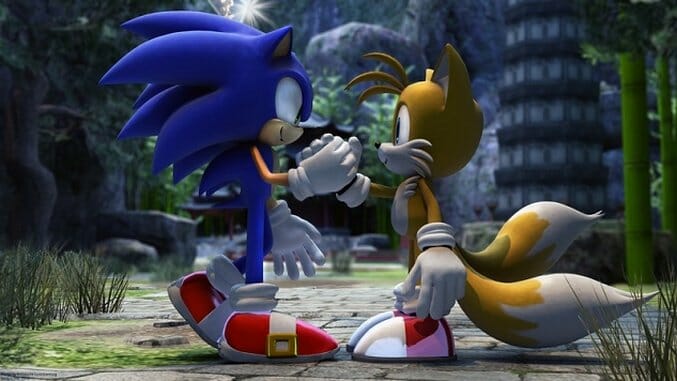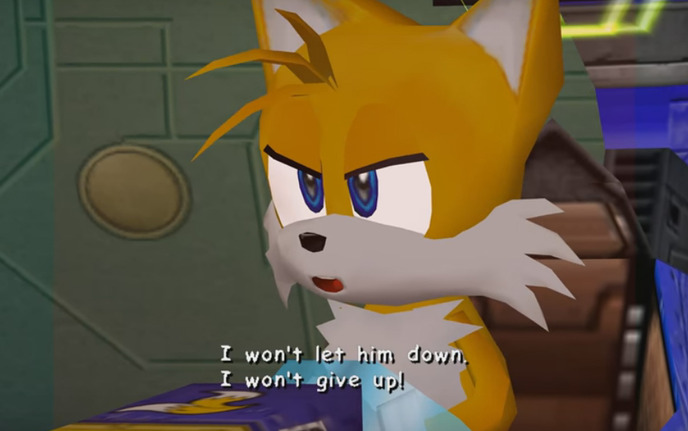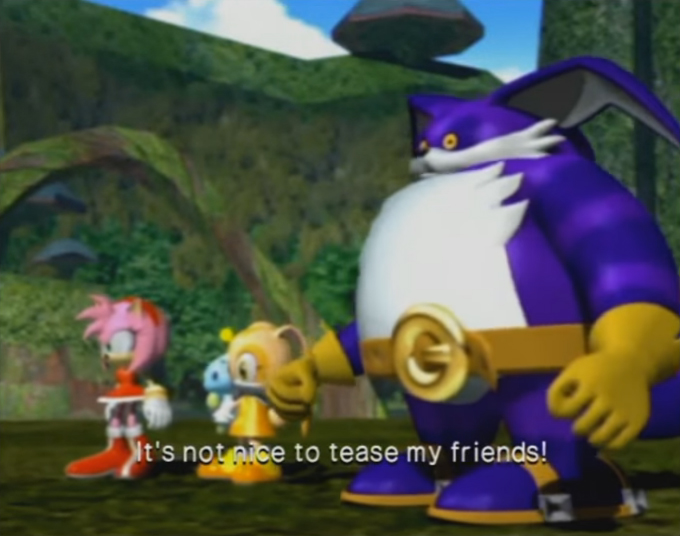
The first Sonic the Hedgehog game came out on 6/23/1991, 25 years ago tomorrow.
Sonic has a hefty crew now, but even his earliest adventures—where secondary characters weren’t so prevalent—feature friendship as a subtext. Sonic’s friendships deepen his world and his character, and have helped create a fictional universe that has brought joy to Sonic fans for 25 years.
It started with Tails, the two-tailed fox we first meet in Sonic the Hedgehog 2. At first he follows his hero wherever he goes, while Sonic seems to be humoring him as he pursues his mission of freeing captured forest animals and stopping Dr. Robotnik. From this early profile, we see Tails as a caddie-like companion, but with Sonic being the fastest thing that moves, we also recognize he doesn’t need to rely on Tails. That is until the quest takes a skyward turn, at which point Tails’ value to Sonic is revealed in his piloting skills. Sonic the Hedgehog 3 continues this dynamic with its opening sequence, where Tails and Sonic are again flying with the Tornado, but only after jumping to 3D does the series explore this theme more fully.
Sonic Adventure, for example, portrays Sonic and Tails as partners and buddies who work in tandem, rather than Sonic always in a leadership role. It’s here that Tails’ skills as an inventor are pushed (e.g., through his Mystic Ruins workshop and invention of the Tornado II), which in turn alters our previous view of him as a straggler who can’t match Sonic. This, too, is supported by the broader context in gameplay styles, as unstoppable speed is no longer equated as the sole measure of strength, giving Tails opportunity to showcase skills unique to him.
Also developed is an aspect of Tails’ character that was previously non-existent: his self-confidence. When the two get separated after the Tornado is shot down, Tails has a flashback of his first encounter with Sonic—something that’s only been suggested in past titles—showing his initial admiration for the hedgehog’s speed. Later, when Tails must alone stop Eggman from detonating a missile that threatens the city, he tells himself during a moment of reflection that he can’t always rely on Sonic to fight the tough battles.
In Sonic Adventure 2, Tails goes from frequently asking where Sonic is, to flying to his rescue and consulting with and directing him on plans. One of these (late-game) plans is disrupted by a failure of colossal proportions, and when a shortsighted comment clinches Sonic’s doom, Tails’ face is that of disappointed realization. Understandably upset over “losing” his friend, he vows to follow through on the one thing Sonic trusted him with while also saying he’ll never forgive Eggman, projecting feelings of guilt and anger.
Whereas the earliest games show Tails in a passive role, these two early incarnations of 3D Sonic show a more complementary relationship: Tails keeps Sonic sensible and acts as his brakes when careless speed could be his undoing. Games like Sonic Colors and Sonic Lost World tackle this, where Tails’ perceptive and methodical approach prompts him to take the fall for his friend. It works both ways, as Sonic is often portrayed as Tails’ protector, shoving him into a getaway elevator to ensure his safety in Sonic Colors and saving him from a group of monsters in Sonic Unleashed. Their close connection—fistbumps, light-hearted banter and all—is even envied by Orbot, as it contrasts the relationship Eggman has with his robotic assistants.
A strong bond can also be found in the maturing relationship between Sonic and former hot-tempered rival Knuckles. After realizing he’d been had in Sonic & Knuckles, the easily-tricked echidna teams up with Sonic to save Angel Island, his “follow me” gesture being the start of a rivalry-turned-friendship with a different flavor of the taunting he did when Sonic was his enemy. Of course, Knuckles’ gullible nature has been exploited in successive games (Sonic the Hedgehog: Triple Trouble, Sonic Advance 2), so whenever they’re on opposing sides, Sonic doesn’t hold back from fighting Knuckles—this is different from the reaction he’d have if Tails were to go against him (like in Sonic Colors, when he was being controlled by Eggman). But the hedgehog and echidna are stronger on the same side than they are fighting each other.
There’s an equal respect between them but also a competitive drive that Knuckles holds onto, as when showing up Sonic for only rescuing a fraction of the animals in Lost World, or quickly announcing in Heroes that Eggman’s defeat was because of his help. And after being rescued in Sonic Generations, Knuckles is reluctant to accept that Sonic helped him out. Not a sidekick in the same way as Tails, he’s often off on his own mission when he learns of Sonic’s business with Eggman and thereafter offers assistance, as in Sonic Adventure 2 and Sonic the Hedgehog (2006). So while he doesn’t normally follow Sonic around, his actions speak well of him as a reliable friend, essentially saying “I’ll be there if you’re ever in need.”
Speaking of Sonic the Hedgehog (2006), it’s true that derision still follows this game closer than Tails follows Sonic, but its story (convoluted as it is) does much to solidify the relationship between Rouge and Shadow. With their mutual-interest alliance in Sonic Adventure 2 as the starting point, wherein they each acted with a hidden purpose in mind (destruction for Shadow, intel for Rouge), the two have since had multiple friendship-building moments. Shadow’s favor in rescuing Rouge from Prison Island is returned when he blacks out in Sonic Battle and gets trapped in the future in Sonic the Hedgehog (2006). That same game also gave birth to a rare moment of genuine connection, where Rouge promised to stand by Shadow even when things looked bleak. Sonic Heroes and Shadow the Hedgehog depict the two as comrades, but individual scenarios show they look out for each other as friends.
Amy’s relentless pursuit of Sonic exceeds any of her other qualities, but during her better moments, she’s shown herself to be a caring friend, one who makes unusual connections. Prison is a great place to make friends, apparently, as it’s because of her that Gamma rejects his programming for a nobler purpose. Then there’s the close pair of Amy and Cream: Amy acts as Cream’s guardian in Sonic Battle, albeit a temperamental one with her overboard workouts; in Shadow the Hedgehog, she organizes a search party to bring Cream back from Cryptic Castle; and in Sonic Rush, their relationship inspires Blaze to be more trusting. She’s been known to befriend robots and animals, but Amy is not childish in her definition of friendship: initially helpful towards Silver in Sonic the Hedgehog (2006), she later withdraws after discovering his true intentions.
Friendship is seen throughout the Sonic series beyond the developed focus on support characters, in both common forms and odd—of the latter, Big and Froggy lead, along with the connection Eggman and Tails share as fellow inventors and the underlying message of Sonic Unleashed. These key moments and relationships are not strictly to deepen story layers; they reflect the high-spirited, personable image of Sonic’s character that echoes in most outings. We can thus always count on Sonic games to accentuate this climate of friendship with the same power as themes of retribution, teamwork, restoration and freedom. In so doing, we find parallels to our present and future selves, the friendships we build in the real world and virtual friendships that have endured for a quarter of a century.
Jose Cardoso is a freelance writer who’s prone to exalting words above people. Fascinated by game design, he has a knack for covering the quirky, niche and overlooked on Nintendo platforms. His writing has appeared in Unwinnable, BeefJack and other publications.

